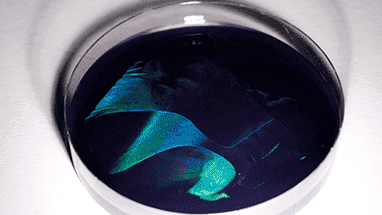
- Light
- Life
- Liberty
- Publications
- Research
Published: | By: Bas Dutilh & Marcel Baecker
We have all seen structural color (SC) in beetles, peacocks, and in mother of pearl, but not everyone knows that these striking reflective colors are generated by nanostructures, and reflect a completely different optical mechanism than conventional dyes and pigments. This natural wonder, often perceived as iridescence, emerges when light interacts with ordered materials, creating a vibrant display of hues. SC is widespread and also exists in bacteria, although its function, genetics, and ecology remain a mystery.
Structurally colored colonies of the marine bacterium Muricauda ruestringensis growing on agar, viewed from three different angles
Image: Colin Ingham, Hoekmine BVWe have all seen structural color (SC) in beetles, peacocks, and in mother of pearl, but not everyone knows that these striking reflective colors are generated by nanostructures, and reflect a completely different optical mechanism than conventional dyes and pigments. This natural wonder, often perceived as iridescence, emerges when light interacts with ordered materials, creating a vibrant display of hues. SC is widespread and also exists in bacteria, although its function, genetics, and ecology remain a mystery.
A few years back we started on what turned out to be a colorful journey. Colin Ingham is the founder of Hoekmine BVExternal link, a biotech company specializing in harnessing iridescent bacteria for innovative materials. As he explains, there is potential value of SC bacteria for biotechnology: “The idea is to create color from non-harmful bacteria to replace dyes that are often polluting and do not suit a sustainable economy”. He has been exploring bacterial SC for several years and was looking to further explore the genomics and ecology of this fascinating phenotype. Together with Henk BolhuisExternal link and Aldert ZomerExternal link we applied for funding from the Dutch Techcentre for Lifesciences (DTLExternal link) and ZonMW in the context of the “Enabling Technologies HotelsExternal link” program to sequence a collection of SC bacteria and do some comparative genomics. But of course we couldn’t stop there… This ended up being a huge collaborative project that brought together our expertise in (meta-) genomics and machine learning with marine microbiology (NIOZExternal link), the German Culture Collection (DSMZExternal link), and photonics (MPIExternal link) to uncover the genomics and ecology of bacterial SC.
We sequenced the genomes of 87 SC and 30 non-SC bacteria and ran GWAS to reveal the associated genes, some of which were shared by SC bacteria from different phyla. Based on this, we developed a Random Forest model and applied it to all bacterial genomes and metagenomes, revealing the “ecogenomics” of SC. What surprised us the most was the abundance of iridescent bacteria in environments without light, such as deep ocean waters. This raised new questions: Why would bacteria in lightless habitats develop such light-reflecting properties? Could this feature serve other ecological functions, such as helping the bacteria colonize floating particles or protecting them from viruses? We’re already working on several follow-up projects to look more into the molecular biology and ecology of SC, so stay tuned for more!
Original Publication
“Structural color in the bacterial domain: The ecogenomics of a 2-dimensional optical phenotype”. Aldert Zomer, Colin J. Ingham, F. A. Bastiaan von Meijenfeldt, Álvaro Escobar Doncel, Gea T. van de Kerkhof, Raditijo Hamidjaja, Sanne Schouten, Lukas Schertel, Karin H. Müller, Laura Catón, Richard L. Hahnke, Henk Bolhuis, Silvia Vignolini, and Bas E. Dutilh. PNAS 121: e2309757121. DOI: 10.1073/pnas.2309757121External link
